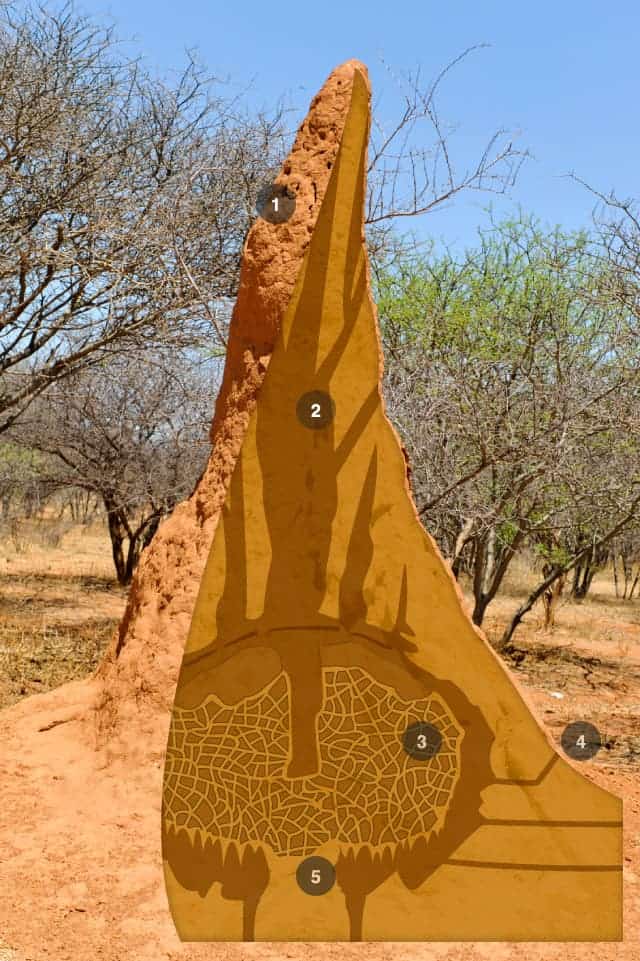We tend to think of termites as pests, but the tiny insects actually play a crucial environmental role, at least in some areas. New research suggests that termite mounds are crucial to stopping the spread of deserts and preserving the vegetation and climate. The results indicate that termite mounds can not only to stop desertification, but also encourage vegetation to expand into deserts.

Termite mounds can be up over 5 meters high and have 30 meters in diameter. They are also very complex and allow water to better permeate the soil, fighting desertification Image via PBS.
Related to cockroaches, termites have a spectacular evolutionary history and are very organized, but are generally regarded as pests – causing structural damage to wooden parts in buildings. But in the savannas and drylands of Africa, South America and Asia, termite mounds are extremely useful, storing nutrients and moisture, allowing water to better penetrate the soil. As a result, vegetation thrives around them and creates ecosystems which couldn’t otherwise exist.
Corresponding author Corina Tarnita, a Princeton assistant professor in ecology and evolutionary biology, explained that termite mounds also preserve seeds and plant life, which helps surrounding areas rebound faster once rainfall resumes.
“The rain is the same everywhere, but because termites allow water to penetrate the soil better, the plants grow on or near the mounds as if there were more rain,” Tarnita said. “The vegetation on and around termite mounds persists longer and declines slower,” she said. “Even when you get to such harsh conditions where vegetation disappears from the mounds, re-vegetation is still easier. As long as the mounds are there the ecosystem has a better chance to recover.”
Desertification is generally regarded as a type of land degradation in which a relatively dry land region becomes increasingly arid, typically losing its bodies of water as well as vegetation and wildlife. Desertification is typically caused by climate change and/or human activities and is a significant global ecological and environmental problem.
Researchers have proposed several mechanisms to halt or at least stall desertification, but as usually, nature provides the best solutions in this case. Jef Huisman, an aquatic microbiology professor and theoretical ecologist at the University of Amsterdam in the Netherlands believes that the desertification process is much more complicated than previous models suggested. For example, the biological activity (like that of termites or mussels) that can “engineer” the environment is often times overlooked.
“This phenomenon and these patterned landscape features are common. It’s not always termites causing them, but they may very well have similar effects on the ecosystem,” Pringle said. “However, exactly what each type of animal does to the vegetation is hard to know in advance. You’d have to get into a system and determine what is building the mounds and what are the properties of the mounds.”
The research was conducted on several fields, in a truly interdisciplinary fashion – as it should be, when dealing with complex environmental issues.
“It’s a great example of interdisciplinary synergy,” Tarnita said. “The team effort was really crucial to this work — each co-author played a vital role. The study started with the theory, which began with discussions between Rob [Pringle] and me and later with input from Kelly [Caylor] and Simon [Levin]. It really took shape once Juan [Bonachela] started to analyze the model and the results were validated with the empirical data collected by Jen [Guyton] and Tyler [Coverdale], and analyzed by Efrat [Sheffer].”
Journal Reference: Elizabeth G. Pringle, Erol Akçay, Ted K. Raab, Rodolfo Dirzo, Deborah M. Gordon. Water Stress Strengthens Mutualism Among Ants, Trees, and Scale Insects. DOI: 10.1371/journal.pbio.1001705










